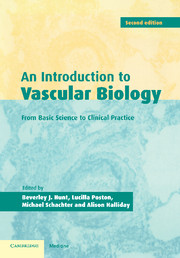Book contents
- Frontmatter
- Contents
- List of contributors
- Preface
- Part I Basic science
- Part II Pathophysiology: mechanisms and imaging
- Part III Clinical practice
- 12 Vascular biology of hypertension
- 13 Atherosclerosis
- 14 Abdominal aortic aneurysm
- 15 The vasculature in diabetes
- 16 The vasculitides
- 17 Pulmonary hypertension
- 18 Role of endothelial cells in transplant rejection
- 19 Vascular function in normal pregnancy and preeclampsia
- Index
19 - Vascular function in normal pregnancy and preeclampsia
Published online by Cambridge University Press: 07 September 2009
- Frontmatter
- Contents
- List of contributors
- Preface
- Part I Basic science
- Part II Pathophysiology: mechanisms and imaging
- Part III Clinical practice
- 12 Vascular biology of hypertension
- 13 Atherosclerosis
- 14 Abdominal aortic aneurysm
- 15 The vasculature in diabetes
- 16 The vasculitides
- 17 Pulmonary hypertension
- 18 Role of endothelial cells in transplant rejection
- 19 Vascular function in normal pregnancy and preeclampsia
- Index
Summary
The maternal cardiovascular system undergoes remarkable adaptive physiological changes in pregnancy in order to provide the growing conceptus with an adequate blood supply, while simultaneously ensuring that the mother's own blood pressure remains within normal limits. The complex processes involved remain incompletely understood but are essential to our understanding of the common cardiovascular disorders in pregnancy, particularly gestational hypertension and preeclampsia. In this review an attempt will be made to summarize the mechanisms known to influence vascular function in the mother in normal pregnancy and to extend this to a discussion of preeclampsia.
Normotensive pregnancy
Cardiovascular haemodynamics
One of the earliest manifestations of the response to pregnancy is a fall in peripheral vascular resistance (Robson et al., 1989). Longitudinal studies using Doppler ultrasound and echocardiography indicate that the decline in systemic peripheral vascular resistance occurs by 5 weeks of gestation and is 85% complete by 16 weeks (Robson et al., 1989; Clapp and Capeless, 1997). As a result, blood flow to several maternal organs increases dramatically; perfusion of the kidneys is raised by 80%, flow to the skin of the hands and feet increases by over 200% and uterine artery flow is elevated by 1000%. Data from the pregnant baboon (Phippard et al., 1986) and pregnant women (Chapman et al., 1998) suggest that the fall in peripheral resistance provides the stimulus for early activation of the renin–angiotensin–aldosterone axis and the resultant rise in plasma volume and cardiac output which is characteristic of normal pregnancy.
- Type
- Chapter
- Information
- An Introduction to Vascular BiologyFrom Basic Science to Clinical Practice, pp. 398 - 426Publisher: Cambridge University PressPrint publication year: 2002



